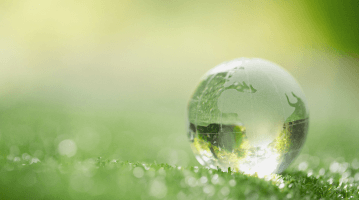How to reconcile economic growth and sustainable development?
Depletion of natural resources, biodiversity loss, global warming... our economic model has shown its limits. Today, economic growth must adopt a sustainable approach in order to meet the challenges of sustainable development.
Truly long-term economic growth
For most of us, sustainable development seems to contradict the economy as we know it. And yet, sustainable development wouldn’t even be possible without the economy, the driving force that helps us meet our most basic needs. But what would a new sustainable economy even look like? Since the 1950s, economic growth has been based on productivity.
The goal is immediate production. As part of a short-term outlook, this approach demands we produce more and faster, whatever the human or environmental “cost”, usually increasing inequality and poor working conditions.
It involves exploitation of natural resources, air, soil and water pollution, greenhouse gas emissions, soil depletion...
This vision is in stark contrast to that of the new economy. These days, the sustainable economy considers human needs in the much longer term. Use of renewable energies, technical innovations designed to reduce consumption, recycling waste and no longer polluting, it’s an economy that takes care of the environment, a new model that meets the immediate needs of all human beings, while guaranteeing they still have a future. This is the green economy.
The green economy
The green economy is a model that emerged at the same time as sustainable development. It adopts all the principles of sustainable development, while retaining respect for nature and acting accordingly. In 2011, the United Nations Development Programme (UNDP) defined it as “an economy that results in improved human well-being and social equity, while significantly reducing environmental risks and ecological scarcities”.
The sector is booming and promises:
- To reduce CO2 and pollution.
- To preserve biodiversity.
- Better yields for less use of natural resources.
Although focussed on the environment, the green economy also incorporates a social component. It creates jobs and incomes, and improves the well-being of employees when they’re at work and the quality of their lives in general. Green business practices significantly improve health and safety conditions for workers. Motivation is also a key to greater efficiency. Environmental protections, technical innovations, motivation and social cohesion, efficiency... by combining economic, social and environmental dimensions, the green economy tends to create a virtuous circle.
Sectors of the green economy
Where can “green” principles be applied? Leading companies are already moving in on the many different fields of application the green economy offers.
Renewable energies
The first sector to be revolutionised in response to resource depletion was energy. From solar and wind to hydro and geothermal, there are so many solutions, the sector is booming!
Eco-construction
From heating to waste disposal, paintwork to roof tiles, eco-construction means respecting the environment in every part of the building process. Fundamentally sustainable, it also incorporates a social dimension by involving stakeholders, promoting the local region and its traditions, as well as focussing on participation, collaboration and solidarity.
Transport and infrastructure
In both rural and urban settings, local authorities are increasingly committed to developing eco-mobility, i.e. helping people get around in clean vehicles, including green energy public transport, developing cycle paths and pavements, electric car infrastructure, etc.
Water and waste management
In the context of a ‘circular’ economy, both waste products and wasted energy and raw materials must be limited. This calls for better water management, from production and distribution to wastewater treatment. Waste management is all about improved sorting, collections, transport, recycling and reuse.
Land planning
The key focus of land planning is to preserve and enhance biodiversity. Whether it’s developing parks and green spaces in towns and cities, or encouraging organic and sustainable agriculture in rural areas, regardless of the specifics, every action we take must consider the impact on the environment.
Promoting urban biodiversity
“My Wild Street” is an inclusive scientific campaign that helps city dwellers learn more about the plant species that grow all around them. The aim is to boost scientific knowledge of the distribution of plant species in our urban environments. Launched in 2011 by France’s Natural History Museum, Klorane Botanical Foundation was keen to support the “My Wild Street” campaign, in partnership with Tela Botanica, to raise awareness of botany among people living in towns and cities and encourage urban biodiversity. Collaboration, solidarity, innovation and creativity... after all, that’s what the economy is all about!

THE THREE PILLARS OF SUSTAINABLE DEVELOPMENT
A holistic vision leading to a new model of society, taking into account the limits imposed by the depletion of natural resources, the need to reduce and eradicate inequalities, and the need to question the ways we generate value.
